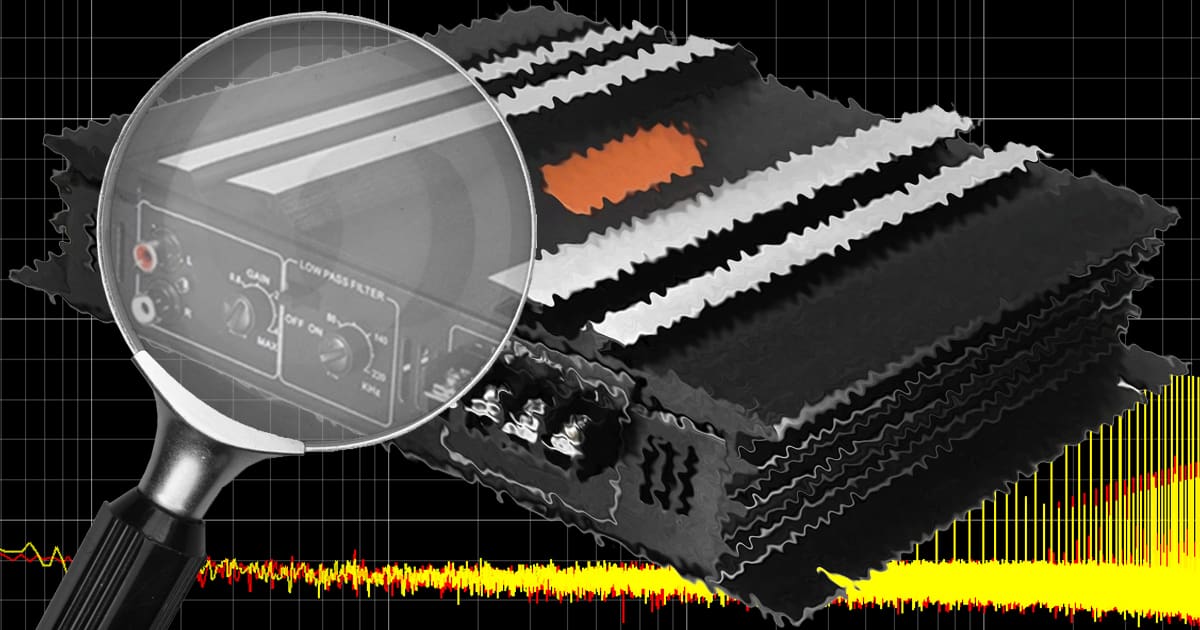We just escaped from one of the most confusing car audio conversations ever. In a social media group dedicated to measuring the harmonic distortion characteristics of amplifiers, a member challenged the importance or validity of the topic. We can’t imagine having that much spare time. OK, well, maybe that’s appropriate in a flat earth group. Anyway, let’s talk about a few different kinds of distortion and how they affect the performance of an amplifier.
Talking About Distortion Isn’t a Discussion About Clipping
We need to start this discussion with a very clear definition. When we talk about amplifier distortion, we aren’t talking about what happens when an amplifier is clipping. This is a concept that many amateurs don’t fully understand.
Any time an audio signal passes through an amplifier, it’s altered in frequency content. Those changes are often difficult to hear if the amp is a high-quality design. If the amp is poor quality, then the changes will be audible.
At the extreme other end of the spectrum is clipping. Clipping adds massive amounts of harmonic distortion to the output of an amplifier. Yes, it’s still distortion, but that’s not what we discuss in defining amplifier quality. Nobody should care how an amplifier behaves when pushed to clipping. Why? Because you should never drive an amplifier to the point that it clips.
Think of clipping like the redline on a car engine. Beyond this engine speed, you can damage the engine’s internal components. Pushing a car audio amp into clipping might not damage it, but it will send a lot of unwanted high-frequency information to your speakers and will likely damage tweeters. You wouldn’t drive around with your engine revving a few thousand RPM beyond redline. As such, ensure that the installer configures your audio system not to push any amp beyond its limits. If the system isn’t loud enough, you need a more powerful amplifier or more speakers.
What Are Harmonics?
Before we discuss distortion, we need to explain the concept of harmonics. In audio frequencies, harmonics are multiples of a specific frequency. Let’s say you have a sound that contains only a 200-hertz tone. This tone would have to be generated electronically, as voices and instruments all add harmonics naturally. Looking at the tone in a spectral graph, you’ll see a spike at 200 hertz and nothing else.
This 200-hertz tone is considered the first harmonic. It can also be called the fundamental frequency. The second harmonic is at twice the frequency of the fundamental. In this example, that would be 400 hertz. The third harmonic is three times the fundamental frequency or 600 hertz. Harmonics can go on to infinity, though the higher levels are typically very minute in amplitude.
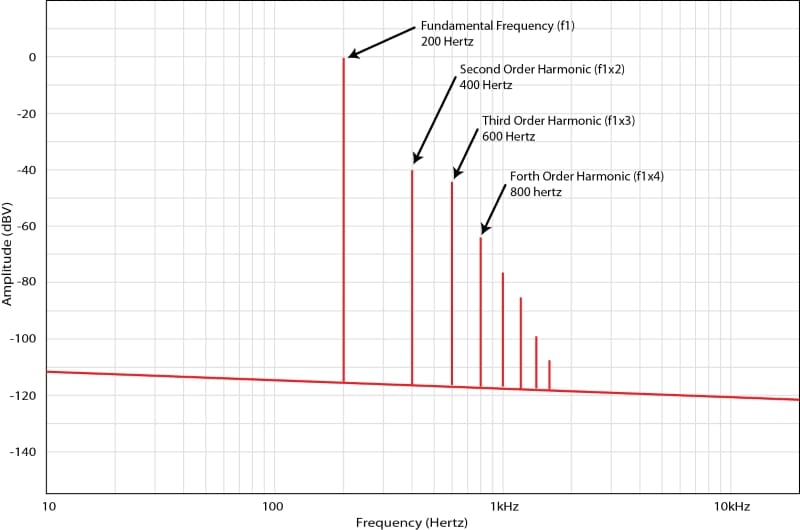
If we are doubling, tripling and quadrupling the frequency each time, why does the space between each harmonic not double on the graph? That answer is that we look at the frequency domain (the scale of the bottom axis) using a logarithmic scale. If we looked at its frequency linearly, it would squish all the bass and midrange information together, making it hard to extract information.
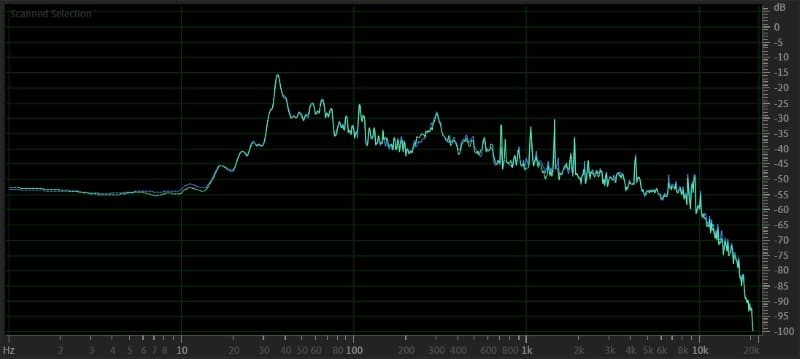
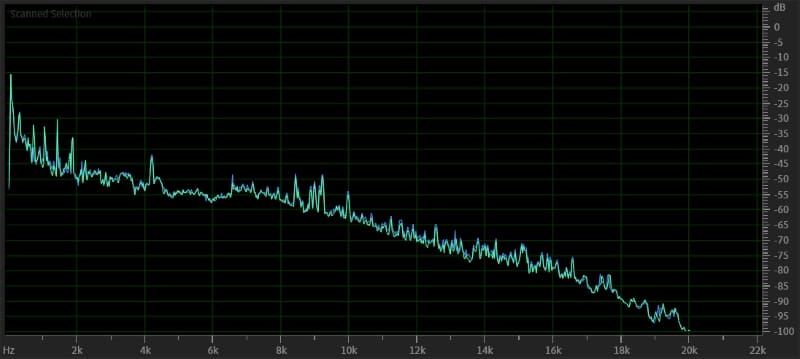
Different Kinds of Amplifier Harmonic Distortion
Two kinds of distortion are prevalent in car audio amplifiers: harmonic distortion and intermodulation distortion. In this article, we are going to discuss the harmonic type. This type of distortion creates unwanted multiples of every frequency that passes through an amplifier. We use % THD to quantify the total distortion an amplifier adds. Specifically, this is a measurement of the physical amplitude of the sum of all the harmonics compared with the amplitude of the original signal. For example, 1% THD means that the total harmonic content is at a level that’s 40 dB below the frequency they are multiplying. Here’s a graphic example.
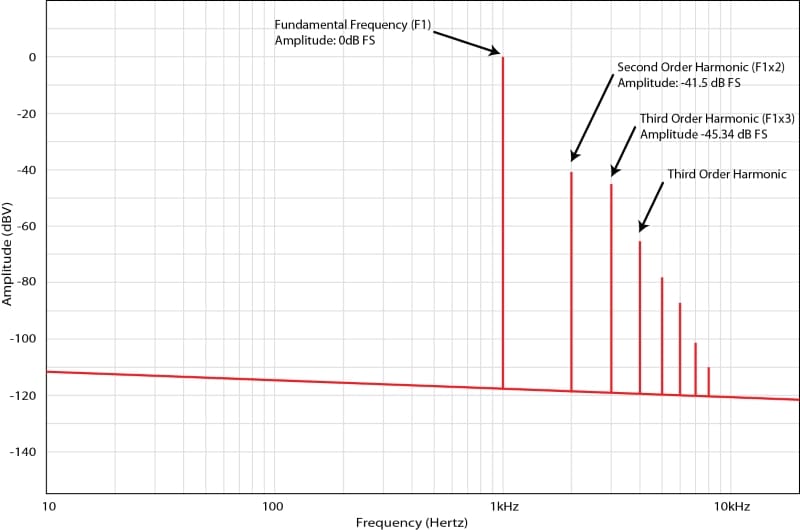
In the above image, we have a single tone or sine wave at a frequency of 1 kHz at a level of 0 dB FS. The spike at 2 kHz is the second harmonic, with a level of -41.5 dB FS. The spike at 3 kHz is the third harmonic, with a level of -45.34 dB FS. I chose these levels as they sum to -40 dB FS, representing 1% THD. In this example, the higher-frequency harmonics (fourth order and above) are low enough in amplitude that they don’t contribute significantly to the measurement. They are akin to adding a few drops to a glass of water.
Harmonics of Everything!
Where things go awry is that most people forget that there are harmonics of every frequency that passes through an amplifier. We never play a 1-kHz tone while driving to work – we listen to music. Here’s a snapshot of a piece of music.
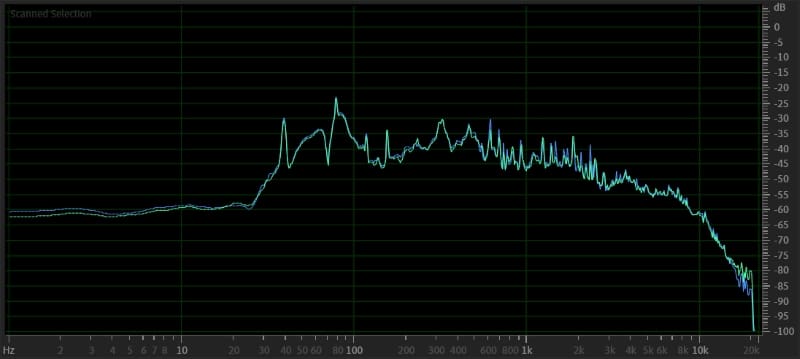
You can see that there is audio information in this song at pretty much every audible frequency from 25 Hz and up. An amplifier will add multiples of every one of those frequencies. The better the amplifier performs in terms of distortion, the less this unwanted frequency information affects the audio signal. Let’s add four additional frequencies to our harmonic distortion chart to put things into perspective.
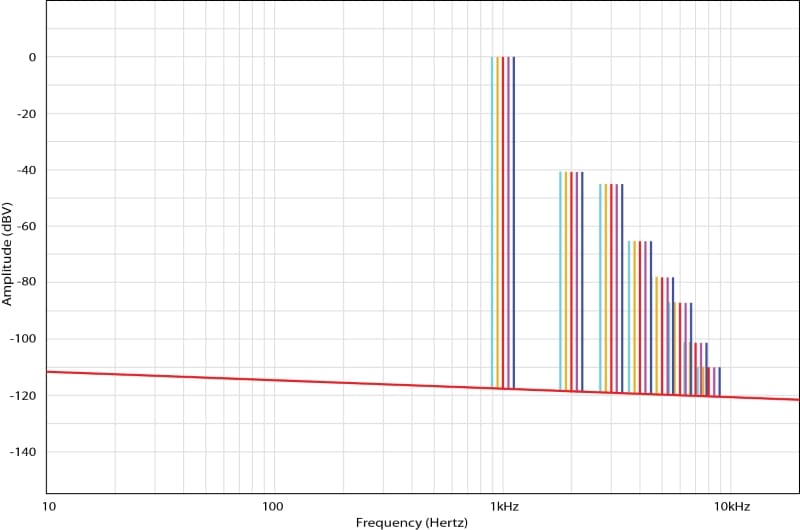
It’s easy to see how quickly the unwanted information adds up. These are just five frequencies. Music has content at almost every frequency. So significant amounts of harmonic distortion make a mess.
Car Audio Amplifiers: The Good and the Ugly
In the real world, few solid-state amplifiers add more than 1% THD under normal listening conditions. One of the best amplifiers we’ve tested, the ARC Audio SE2300, has a 1-kHz, 1-watt THD distortion measurement at about 0.0035% THD. This measurement means the sum of the harmonics is at a level of approximately -89 dB below the audio signal. This makes them hard to hear.
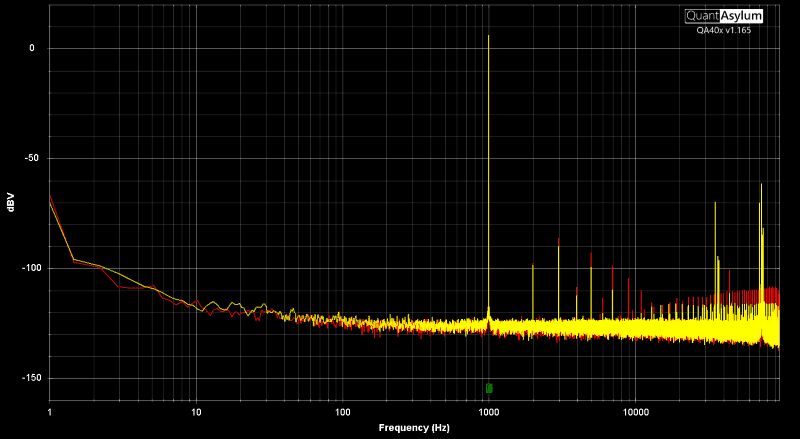
At the other end of the spectrum, we tested an amplifier from a popular online store. No, it’s not a Skar Audio amp; those test much better than this one. Here’s the spectral analysis of the same 1-kHz test tone through this Class AB amplifier.
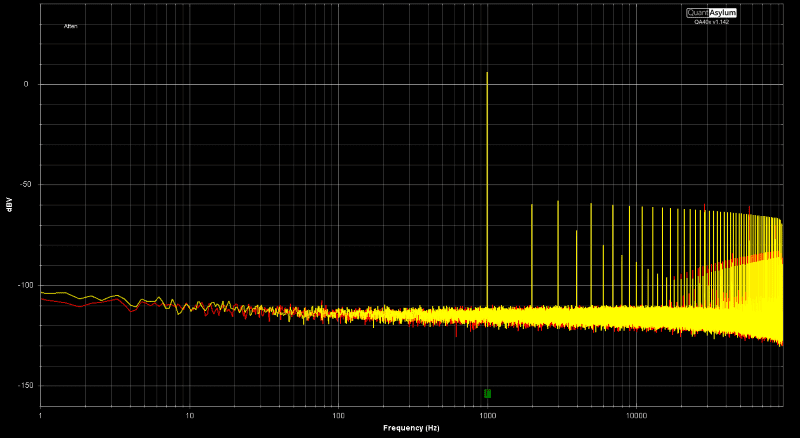
This is the worst or second-worst amplifier we’ve ever tested in the lab. The THD at this level is 0.18%. The tiny little amplifier ICs built into car radios are orders of magnitude better than this. It was appalling.
Even- or Odd-Order Harmonics
If you’re into home audio equipment, you’ve likely heard people say that vacuum tube amplifiers add pleasing harmonics, and solid-state amplifiers add unnatural harmonics. We avoid generalizing about amplifier topologies as their performance depends significantly on who designed the amplifier. For example, we know of many Class D amplifiers that sound exponentially better than Class AB amplifiers.
Nevertheless, there is something to be said of the prominence of the harmonic being second or third order. If you play an instrument, then you know that playing two notes at once can, depending on which note they are, sound pleasant, or they might sound harsh or sour. Even-order harmonics (second, fourth, sixth, and beyond) are considered to be more musical than odd-order harmonics (third, fifth, seventh, etc.).
While it is better to have no harmonic information, even-order harmonics would be less annoying if they were prominent. In the case of our two examples, the ARC produces a third-order harmonic that’s about 8 dB louder than the second-order. Remember, neither will be very audible as their amplitude is very low. The internet amp has all the bases covered! It produces lots of both kinds, which is useless on many levels.
The Tube Amp Stereotype
Let’s do some digging for distortion measurements of vacuum tube amplifiers. We looked at the 10 most recent tube amplifier reviews on Stereophile.com that included measurements of the spectral content of a 50-Hz, 1-watt signal. Only one showed second-order harmonics as significantly higher than the third-order. In most cases, the harmonic content was similar for the second and third. By the way, this is a $20,000 stereo amplifier operating in ultra-linear mode.
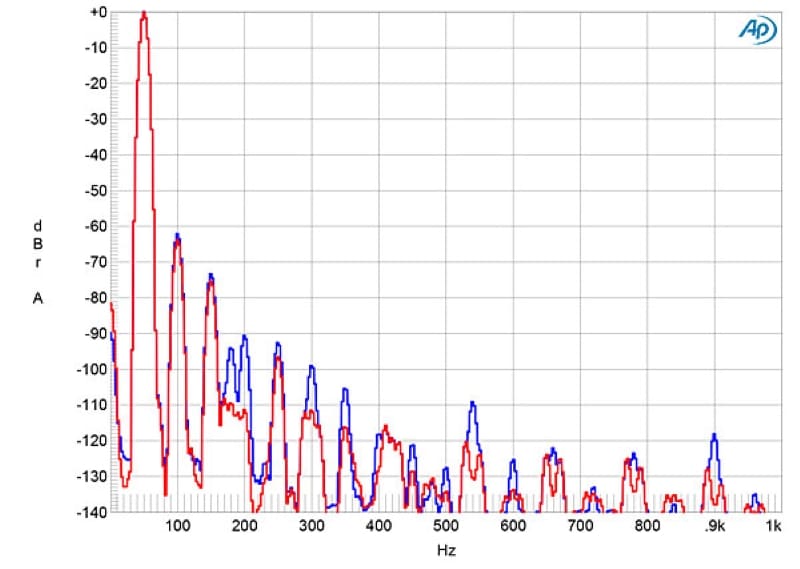
Now you know why we avoid generalizations about topologies. “Tubes sound good because of even-order harmonics” isn’t easy to substantiate. Further, in terms of overall distortion, this amplifier, as measured, is producing 0.074% THD – which, by any standard, is pretty bad.
Can You Hear This Harmonic Distortion?
I recall someone trying to justify that even 0.18% THD would be hard to hear. The logic seems sound. Will music played through the “bad” amp be hard to make out? No, it will still basically sound the same. Will it be as clear and defined as music played through the good amp? Not even close. The point of these articles is to describe the characteristics that separate one amplifier from another. Quantifying how much distortion is acceptable is an entirely different topic that might be impossible to put a number on. In our experience, amplifiers with THD numbers better than 0.0099-ish sound different (and better) than those in the 0.065 to 0.01 range. An amplifier with a THD spec that’s 0.1% or worse is more of a failed high-school project than something a consumer should purchase. Nevertheless, people buy this junk all the time.
When it’s time to buy a new amplifier for your car audio system, drop by a local speciality mobile electronics retailer and ask for a demonstration. Listen to how clear each instrument and voice is. Listen to how “tight” the percussion sounds. If voices sound warm or harsh on one amp versus another, you may have stumbled across a distortion issue.
More From Our “Amplifier Differences” Series
- Part 1: Frequency Response explores how amplifiers handle different frequencies and how this affects the sound. It discusses the ideal of uniform amplification across all frequencies and examines how real-world amplifiers compare, using specific models for illustration.
- Part 2: Noise delves into the noise that amplifiers can add to the audio signal, how it’s measured, and its impact on sound quality. It explains the signal-to-noise ratio and how different amplifiers manage noise, including the effect of amplifier size on noise performance.
- Part 3: Harmonic Distortion discusses the concept of harmonic distortion, how it affects sound quality, and the performance of different amplifiers in minimizing it. It also touches on the distinction between even- and odd-order harmonics.
- Part 4: Distortion Versus Power Level and Frequency examines how distortion levels in amplifiers change with power levels and frequencies, highlighting the differences between high-quality and low-quality amplifiers in handling distortion.
- Part 5: Intermodulation Distortion focuses on intermodulation distortion, how it’s measured, and its effect on sound quality. It contrasts the performance of different amplifiers in managing IMD.
- Part 6: Car Audio Amplifier Crosstalk addresses how crosstalk between channels in an amplifier can affect the stereo imaging and soundstage of car audio systems, impacting the overall listening experience.
